Archive:Freight transport statistics
- Data from July and October 2014. Most recent data: Further Eurostat information, Main tables and Database. Planned article update: January 2016.
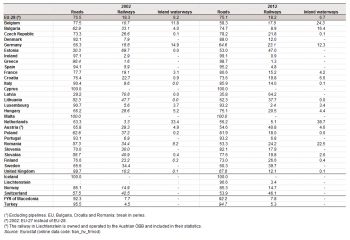
(% of total inland tkm) - Source: Eurostat (tran_hv_frmod)
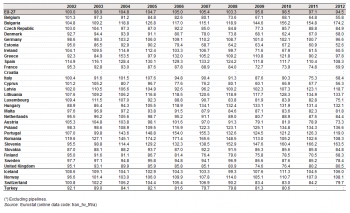
2002–12 (¹)
(Index 2000 = 100) - Source: Eurostat (tran_hv_frtra)
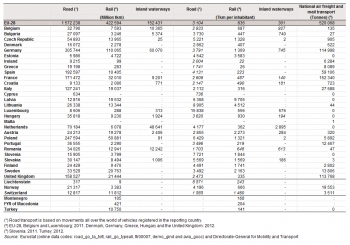
- Source: Eurostat (road_go_ta_tott), (rail_go_typeall), (ttr00007), (demo_gind) and (avia_gooc) and Directorate-General for Mobility and Transport
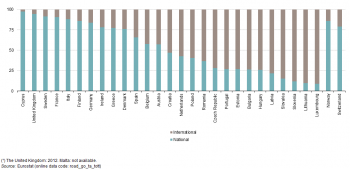
2013 (¹)
(% based on million tkm of laden transport) - Source: Eurostat (road_go_ta_tott)
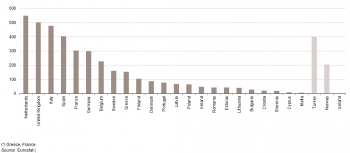
2013 (¹)
(Million tonnes) - Source: Eurostat (mar_go_aa)
This article presents information on freight transport in the European Union (EU), which includes the following transport modes: road, rail, air, maritime and inland waterways. The ability to move goods safely, quickly and cost-efficiently to markets is important for international trade, national distributive trades and economic development. The rapid increase in global trade up to the onset of the global financial and economic crisis and the deepening integration of an enlarged EU, alongside a range of economic practices (including the concentration of production in fewer sites to reap economies of scale, delocalisation, and just-in-time deliveries), may explain the relatively fast growth of freight transport across the EU.
By contrast, strains on transport infrastructure (congestion and delays), coupled with constraints over technical standards, interoperability and governance issues may slow down developments within the EU’s freight transport sector.
Main statistical findings
Total inland freight transport in the EU-28 was estimated to be close to 2 100 billion tonne-kilometres (tkm) in 2012; some three quarters (75.1 %) of this freight total was transported over roads (see Table 1). The share of EU-28 inland freight that was transported by road was more than four times as high as the share transported by rail (18.2 %), while the remainder (6.7 %) of the freight transported in the EU-28 in 2012 was carried along inland waterways. It should be noted that this analysis refers only to inland freight transport and that considerable amounts of freight may be transported by maritime freight services and for some product groups by air transport or by pipelines. Note also that all inland freight transport within Cyprus and Malta was by road due to the absence of any railways or inland waterway infrastructure; this was also the case in Iceland.
Road transport accounted for more than 90 % of inland freight transport in Ireland, Greece, Spain, Luxembourg and Portugal in 2012, as it did in Liechtenstein, Turkey and the former Yugoslav Republic of Macedonia. By contrast, road transport accounted for just over one third (35.8 %) of inland freight transported in Latvia, while the remainder (64.2 %) was transported by rail. Between one half and one third of the inland freight transported in Estonia, Austria, Sweden and Lithuania was carried by rail in 2012; this was also the case in Switzerland.
More than one tenth of total inland freight in Germany and Bulgaria was transported on inland waterways in 2012, with this share increasing to just under one quarter in Romania and Belgium, and peaking at 38.7 % in the Netherlands.
The relative importance of road freight transport, as a share of total inland freight transport, was relatively unchanged in the EU between 2002 and 2012; note that the figures presented for the first period are for the EU-27 and therefore exclude Croatia. As the share of inland freight carried by road remained just above three quarters of the total, the share carried by rail was also relatively unchanged over the most recent decade for which data are available; there was, during the same period, a modest increase in the relative share of inland waterways.
Particularly large increases in the share of freight transported by road (2002–12) were recorded in Estonia and several eastern Member States: the share of road transport in Estonia increased by 22.7 percentage points, while double-digit growth rates were also recorded for Poland (19.3 points), Slovakia (18.9 points), Slovenia (12.1 points) and Bulgaria (11.8 points). By contrast, the share of inland freight that was transported by road fell in 11 EU Member States between 2002 and 2012, most notably in Belgium (-19.2 percentage points) and Austria (-11.2 points). In most of the EU Member States the change in the share of freight transported by road was accompanied by a similar and opposite change in the share transported by rail, although Romania, Belgium and Bulgaria recorded substantial increases in their shares of inland freight transported by inland waterways.
Inland freight transport grew at a slower pace in the EU-27 than constant price gross domestic product (GDP) during the period from 2000–12; this can be seen from the index shown in Table 2, as the index value in 2012 was 5.5 % lower than its average level for 2000. It should be noted that the index of inland freight transport relative to GDP peaked in 2007 (105.4), and that it was consistently above 100 during the period 2004–08, indicating that inland freight transport had increased more rapidly than GDP between 2000 and the start of this period. With the onset of the global financial and economic crisis, the index fell sharply in 2009 (as the decline in constant price GDP outweighed the reduction in the quantity of freight transported). Thereafter, the index of inland freight transport relative to GDP followed a fluctuating development through to 2012.
Comparing with the situation in 2000, Bulgaria and Slovenia recorded the greatest increases in inland freight transport relative to GDP, with their respective indices more than 60 % higher in 2012. The rate of change in inland freight transport was at least 30 % higher than the overall growth in economic activity during the period 2000–12 in Poland, Lithuania and Hungary. By contrast, the ratio of inland freight transport to GDP fell at its most rapid pace between 2000 and 2012 in Ireland, Cyprus, Belgium and Estonia, in each case down by more than 40 %.
Road freight
Relative to population size, road freight transport was highest among the EU Member States in Luxembourg, where, on average, nearly 16 000 tonne-kilometres (tkm) of freight were transported by road for each inhabitant in 2013; this was almost double the next highest level of road freight transport per inhabitant, recorded in Lithuania (8 905 tkm). In both cases, the vast majority — more than 90 % — of the freight transported by road was international movements performed by vehicles registered in these two EU Member States. Note that road freight statistics are based on movements in the registration country or abroad, of vehicles registered in the reporting country (‘nationality principle’).
For most freight hauliers registered in the EU, international road freight transport relates to transport in other EU Member States. However, the split between national and international road freight varied considerably across the EU Member States (see Figure 1): the highest proportions of national road freight transport were recorded in Cyprus (97.5 %) and the United Kingdom (94.7 % in 2012), while shares in Sweden and France were also above 90 %. By contrast, in 2013, half of the EU Member States reported that foreign road networks accounted for the majority of the goods transported by vehicles registered in their country. The share of international road freight transport in the total quantity of goods transported by road was particularly high in Slovakia (84.9 %), Slovenia (88.1 %), Lithuania (90.4 %) and Luxembourg (91.0 %).
Air freight
About 14.4 million tonnes of air freight (both national and international) was carried through airports within the EU-28 in 2013, this marked a slight increase of 0.4 % when compared with 2012. Having reached 14.1 million tonnes of air freight in 2008, there was a considerable reduction in the quantity of goods transported by air in 2009 (down 12.6 %). The rebound in activity the following year was even larger, as growth of 16.1 % was recorded in 2010. Thereafter, the quantity of air freight for the EU-28 developed at a much slower pace, with an annual increase of 3.0 % in 2011, largely cancelled out the following year (-2.0 %). Overall, the quantity of goods transported by air in the EU-28 was 2.7 % higher in 2013 than it had been at the onset of the financial and economic crisis in 2008.
Airports in Germany dealt with 4.2 million tonnes of air freight in 2013, considerably more than in any other EU Member State (see Figure 2); the United Kingdom had the second highest amount of air freight, at 2.4 million tonnes. Some of the smaller EU Member States are relatively specialised in air freight, notably all of the Benelux countries, and in particular, Luxembourg (which ranked as the seventh largest air freight transporter among the EU-28 Member States).
Maritime freight
Maritime ports in the EU-28 handled 3 739 million tonnes of seaborne goods in 2012, which marked a slight reduction of 0.8 % when compared with 2011. Having risen during the period 2002–07, the quantity of freight transported by sea peaked at 3 968 million tonnes before the financial and economic crisis. There was little change in 2008, before a reduction of 12.1 % in 2009, which was, to some degree, reversed in 2010 and 2011, when the EU-28’s quantity of seaborne goods rose by 5.8 % and 2.7 %. Nevertheless, in 2012, the quantity of goods transported by sea remained almost 6 % below its pre-financial and economic crisis peak.
Sea ports in the Netherlands and the United Kingdom each handled more than 500 million tonnes of goods in 2013, while in Italy the level was slightly lower (see Figure 3). These three EU Member States collectively handled about 40 % of the EU-28’s seaborne freight.
Data sources and availability
The development of freight transport statistics is based upon a raft of framework legislation and implementing legislation, generally organised according to the mode of transport under consideration. Statistics on inland freight transport are available with an annual frequency and time series generally begin in the early 1990s. The majority of inland freight transport statistics are based on movements in each reporting country, regardless of the nationality of the vehicle or vessel involved (the ‘territoriality principle’). For this reason, the measure of tonne-kilometres (tkm, in other words, one tonne of goods travelling a distance of one kilometre) is generally considered as a more reliable measure, as the use of tonnes entails a higher risk of double-counting, particularly for international transport. The methodology used across the EU Member States is not completely harmonised: for example, road freight statistics are generally based on all movements (in the registration country or abroad) of vehicles registered in the reporting country (the ‘nationality principle’).
The modal split of inland freight transport is based on transportation by road, rail and inland waterways, and therefore excludes air, maritime and pipeline transport. It measures the share of each transport mode in total inland freight transport and is expressed in tonne-kilometres.
The level of inland freight transport (measured in tonne-kilometres) may also be expressed in relation to GDP; within this article the indicator is presented based on GDP in constant prices for the reference year 2000, with the series converted into an index with a base of 2000 = 100. This indicator provides information on the relationship between the demand for freight transport and the size of the economy and allows the intensity of freight transport demand to be monitored relative to economic developments.
Goods loaded are those goods placed on a road vehicle, a railway vehicle or a merchant ship for dispatch by road, rail or sea. The weight of goods transported by rail and inland waterways is the gross-gross weight. This includes the total weight of the goods, packaging, and the tare weight of the container, swap-body and pallets containing goods; in the case of rail freight transport, it also includes road goods vehicles that are carried by rail. By contrast, the weight measured for maritime and road freight transport is the gross weight (in other words, excluding the tare weight).
Road freight
Road freight transport statistics are collected under the framework provided by Regulation 1172/98 on statistical returns in respect of the carriage of goods by road, substantially amended several times, and recast as Regulation Regulation 70/2012. The data are based on sample surveys carried out in the reporting countries and record the transport of goods by road, as undertaken by vehicles registered in each of the EU Member States. It is important to note that almost all of the EU Member States apply a cut-off point for carrying capacity under which vehicles are not surveyed; this should not be greater than 3.5 tonnes carrying capacity, or 6 tonnes in terms of gross vehicle weight; some of the EU Member States also apply a limit on the age of the vehicles surveyed.
Rail freight
Rail freight data are collected under the framework provided by Regulation 91/2003 on rail transport statistics. The data are collected for a quarterly frequency (usually limited to larger enterprises) and for an annual frequency (covering enterprises of all sizes). Statistics for rail freight are not available for Malta and Cyprus (or Iceland) as they do not have a railway infrastructure. Rail statistics are also collected every five years in relation to a regional analysis (NUTS level 2).
Aside from the mandatory collection of data based on legal acts, Eurostat also collects rail transport statistics through a voluntary data collection exercise. The questionnaire used for this exercise provides information in relation to railway transport infrastructures, equipment, enterprises, traffic and train movements.
Maritime freight
The legal framework for the collection of statistics on maritime freight transport is Directive 2009/42/EC on statistical returns in respect of the carriage of goods and passengers by sea (Recast). Maritime transport data are available for most EU Member States from 2001 onwards, although some countries have provided data back to 1997. Statistics on maritime freight are not transmitted to Eurostat by the Czech Republic, Luxembourg, Hungary, Austria and Slovakia as they have no maritime ports.
Inland waterways freight
The legal framework for the collection of statistics on inland waterway freight transport is Regulation 1365/2006 on statistics of goods transported by inland waterways. Data on inland waterways are only required for those EU Member States with an annual quantity of goods transported that exceeds one million tonnes, namely: Belgium, Bulgaria, the Czech Republic, Germany, France, Croatia, Luxembourg, Hungary, the Netherlands, Austria, Poland, Romania, Slovakia and the United Kingdom. Data collection is based on an exhaustive survey of all inland waterway undertakings for all goods that are loaded or unloaded. In the case of transit, some countries make use of sampling methods in order to estimate the quantity of goods.
Air freight
The legal framework for air transport statistics is provided by Regulation 437/2003 on statistical returns in respect of the carriage of passengers, freight and mail by air. Statistics on air freight are collected for freight and mail loaded and unloaded in relation to commercial air flights. The information is broken down to cover national and international freight transport.
Air transport statistics are collected at the airport level by the EU Member States, Norway, Iceland, Switzerland and candidate countries. Annual data are available for most of the EU Member States for the period from 2003 onwards, while some countries have provided data back to 1993. Air freight statistics are also collected for a monthly and a quarterly frequency and with a regional analysis (NUTS level 2).
Context
As part of its review of transport policy through to 2010, the European Commission made a number of suggestions for new policy developments, which were subsequently expanded upon in the form of a series of Communications, including:
- the EU’s freight transport agenda: boosting the efficiency, integration and sustainability of freight transport in Europe (COM(2007) 606 final);
- a freight transport logistics action plan (COM(2007) 607 final);
- a move towards a rail network giving priority to freight (COM(2007) 608 final);
- a European ports policy (COM(2007) 616 final);
- a ‘Greening transport’ package (COM(2008) 433 final);
- a set of strategic goals and recommendations for the EU’s maritime transport policy until 2018(COM(2009) 8 final);
- a European maritime transport space without barriers (COM(2009) 10 final).
This was followed in mid-2009 by a Communication titled ‘A sustainable future for transport: towards an integrated, technology-led and user friendly system’ (COM(2009) 279 final) and in March 2011 by a White paper titled ‘Roadmap to a single European transport area — towards a competitive and resource efficient transport system’ (COM(2011) 144 final). This comprehensive strategy contains a roadmap of 40 specific initiatives for the next decade to build a competitive transport system that aims to increase mobility, remove major barriers in key areas and fuel growth and employment.
More details concerning the European Commission’s proposals for transport policy initiatives are provided in an introductory article on transport in the EU.
See also
Further Eurostat information
Publications
Statistical books
Statistics in Focus
- Continued recovery in volume of goods handled in EU ports, Statistics in Focus, 7/2013
- Inland waterways freight transport — quarterly and annual data, Statistics in Focus, 42/2012
- Decline in European road freight transport in 2011 reflecting the economic climate, Statistics in Focus, 38/2012
- Modal Split of freight transport according to the territoriality principle (2008-2009), Statistics in Focus, 13/2012
- Strong recovery in rail freight transport performance in the first nine months of 2010, Statistics in Focus, 10/2012
Main tables
- Transport, see:
- Regional transport statistics (t_tran_r)
- Maritime transport of freight, by NUTS 2 regions (tgs00076)
- Air transport of freight, by NUTS 2 regions (tgs00078)
- Transport, volume and modal split (t_tran_hv)
- Volume of freight transport relative to GDP (tsdtr230)
- Modal split of freight transport (tsdtr220)
- Railway transport (t_rail)
- Goods transport by rail (ttr00006)
- Road transport (t_road)
- Goods transport by road (ttr00005)
- Inland waterways transport (t_iww)
- Goods transport by inland waterways (ttr00007)
- Maritime transport (t_mar)
- Sea transport of goods (ttr00009)
- Air transport (t_avia)
- Air transport of goods (ttr00011)
Database
- Transport, see:
- Multimodal split (tran)
- Transport, volume and modal split (tran_hv)
- Railway transport (rail)
- Road transport (road)
- Inland waterways transport (iww)
- Oil pipeline transport (pipe)
- Maritime transport (mar)
- Air transport (avia)
Dedicated section
Methodology / Metadata
Reference manuals
- Rail transport statistics methodology, version 8.01 — January 2015
- Reference manual on air transport statistics, version 11
- Reference manual on inland waterways transport statistics, version 7.1
- Reference manual on maritime transport statistics, version 2014
- Road freight transport methodology
volume 1: reference manual for the implementation of Council Regulation No 1172/98/EC on statistics on the carriage of goods by road - Road freight transport methodology
volume 2: methodologies used in surveys of road freight transport in Member States and Candidate Countries
ESMS metadata files
- Inland waterways transport (ESMS metadata file — iww_esms)
- Maritime transport (ESMS metadata file — mar_esms)
- Modal split of freight transport (ESMS metadata file — tran_hv_frmod_esms)
- Common Questionnaire for Inland Transport Statistics (ESMS metadata file — rail_if_esms)
- Road freight transport (ESMS metadata file — road_go_esms)
Source data for tables and figures (MS Excel)
Other information
- Illustrated Glossary for Transport Statistics — 4th edition, 2010
- Regulation 70/2012 of 18 January 2012 on statistical returns in respect of the carriage of goods by road (recast)
External links
- European Commission: Transport
- Freight transport logistics in Europe
- International Transport Forum — ITF (formerly the European Conference of Ministers of Transport (ECMT))
- United Nations Economic Commission for Europe (UNECE) — transport statistics
